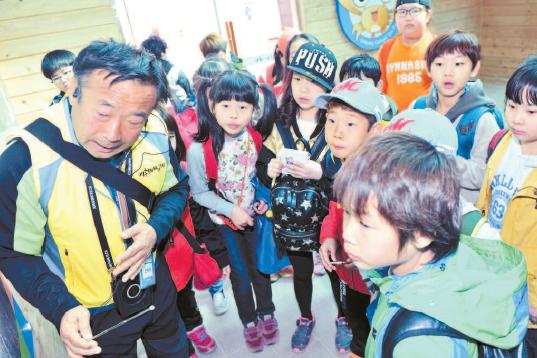Siheung program expands learning

Oh Hwan-bong, left, a guide at Gaetgol Ecological Park, tells students about the park’s water wheel on April 2. Provided by the Gyeonggi Provincial Office of Education
“This is Siheung Gaetgol,” he began, “which was formerly a saltern where salt was produced.”
“In 2012, this area was designated as a national protection area, with salt plants, sand crabs and Saunders’s gulls all living here. If you follow my instructions, you might be able to see them.”
The children - equipped with notebooks and cameras - closely followed behind Oh as he made his way through the park. On that day, the students got the chance to get a close-up look at plants like the phacelurus, in the grass family, and operate a water wheel built to raise sea water into the former saltern.
“Everything I learned here is so much easier to understand than the things I’ve heard in school because I could see and touch them,” said fourth-grader Park Seon-jeong, who attends Kunseo Elementary School.
But the school outing that day was no ordinary field trip. Rather, it’s part of a new kind of educational program currently being tested by the Siheung City Government and Siheung Office of Education.
Launched with the slogan, “Everywhere in Siheung Is a School, Every Resident a Teacher,” the program contains 17 classes related to the local community - covering subjects like ecology, culture, history and the environment - and is provided to local schools.
Classes are also designed to complement schools’ curricula.
With help from area teachers, city officials associated each class in the program with the curriculum set for each grade at local schools.
In the astronomy class, for instance, an expert provides a lecture to fifth- and sixth-grade students at the Siheung Agriculture Technology Center, which is equipped with its own observatory. The program was originally offered and promoted by city officials, but failed to draw interest from local schools.
After Gyeonggi Education Superintendent Lee Jae-joung took office in 2014, city authorities more aggressively pushed for the program’s implementation as he pursued a new educational policy in which the regional government, the education office and area schools could collaborate.
Teachers quickly jumped on board, and reactions to the program have so far been favorable. Last month, 2,328 local elementary, middle and high school classes submitted applications for the program, which is only designed to accommodate 541.
“Despite living here, most students don’t know anything about Siheung,” said Kunseo Elementary School teacher Kim Jeong-sik. “Coming out here also engaged children who before weren’t interested in class.”
The program also provides great learning opportunities, added Oh, the park guide.
“I bought history books about the city so I could tell more stories,” he said. “I thought I knew everything about Siheung, but I was wrong.”
The Gyeonggi Provincial Office of Education is currently planning to expand the program across the province.
BY CHOI MO-RAN [nam.yoonseo@joongang.co.kr]










with the Korea JoongAng Daily
To write comments, please log in to one of the accounts.
Standards Board Policy (0/250자)